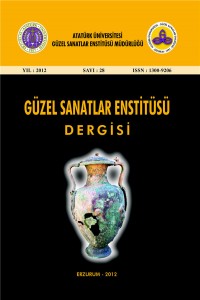VAN KALESİ’NDE BİR DİNİ MİMARLIK ÖRNEĞİ: SÜLEYMAN HAN CAMİİ RESTORASYON ÇALIŞMALARI / A RELIGIOUS ARCHITECTURE SAMPLE IN VAN CASTLE: SULEYMAN KHAN MOSQUE RESTORATION
Abstract
Özet
Süleyman Han Camii, Van Kalesi’nin en üst bölümünde oldukça
engebeli bir alanda inşa edilmiştir. Van Kalesi’nin adeta simgesi olan
Süleyman Han Camii, Van halkı tarafından “Kale Üstü Camii” olarak
bilinmektedir.
Kanuni Sultan Süleyman’ın Irakeyn Seferi sırasında caminin esaslı
onarımı mimar Sinan tarafından yapılmıştır. Evliya Çelebi,
Seyahatnamesi’nde caminin üzerinin kubbe ile örtülü olduğunu belirtmiştir.
19. yy. sonuna ait Osmanlı Saray Albümündeki fotoğraf ve 1848’de Jules
Laurens’in yaptığı gravürde ise caminin düz dam ile örtülü olduğu
görülmektedir. Cami formuna uygun olarak üst örtü sistemi de ilk önce
merkezi bir kubbe ile kapatılmıştır. Ancak, 1655’te Van da meydana gelen
depremde cami tamamıyla yıkılmıştır. Daha sonraki onarımlarda cami beden
duvarlarında kerpiç yapı malzemesi ve geleneksel Van mimari yapım tekniği
kullanılarak üzeri düz bir dam ile örtülmüştür. Cami, 1915-1918 Rus
İşgalinde tamamıyla yıkılmıştır.
Van Kalesi’nde bir dini mimarlık örneği olan Süleyman Han Camii,
korunması gerekli kültür varlığı özelliği gösterdiğinden, tescil edilmiştir.
Camiinin ilk bilimsel kazı çalışmaları İstanbul Üniversitesi tarafından 1983
yılında yapılmıştır. Van Valiliği İl Özel İdaresi tarafından Koruma Projesi
kapsamında rölöve, restitüsyon ve restorasyon projeleri hazırlatılmış ve
restorasyon çalışmaları tamamlanarak, 95 yıl sonra ilk kez 17 Eylül 2010
tarihinde ibadete açılmıştır.
Yapının son restorasyonunda yörenin geleneksel yapım teknikleri ve
moloz taş, ahşap, tuğla, kerpiç gibi yapı malzemesinin yanı sıra odun külü
katkılı çamur bağlayıcı malzeme olarak kullanılmıştır. Bildiride, Süleyman Han Camii ayrıntılı bir şekilde tanıtılmış ve restorasyon bağlamında
irdelenmiştir.
Abstract
Suleyman Khan Mosque has been constructed in a considerably
rough area taking place on the uppermost part of Van Castle. Suleyman
Khan Mosque is a kind of symbol of Van Castle and it is known as ‘’Castle
Upper Mosque’’ by the people of Van.
The Mosque has been well repaired during Suleyman the
Magnificent’s Irakeyn Campaign by Architect Sinan Evliya Çelebi who has
promenaded the region, and in his Travek Book he has stated that the
Mosque’s top was covered with the dome. In the photograph belonging to
the end of 19th century and taking place in the Ottoman Palace Album and
in the gravure done by Jules Laurens in 1848, it is seen that the Mosque was
covered with flat roof. In compliance with its form, the Mosque was covered
with top coverage system and this was first done as the central dome.
However, in 1665, the Mosque has been demolished completely in the
earthquake in Van. In the later repairs, the Mosque has been covered with
flat roof by using adobe structure material on its main walls and by using
traditional Van construction technique. The Mosque has been demolished
again completely in 1915-1918 Russian invasions.
Suleyman Khan Mosque is a religious architecture sample in Van
Castle and it has registration because it shows the characteristics of a cultural
asset required to be protected. First scientific excavation works of the
Mosque has been done in 1983 by Istanbul University. Its building survey,
restitution and restoration projects have been prepared by Van Governorate’s
Province Special Administration in the scope of Protection Project and its
restoration works have been completed, and 95 years later, for the first time
after its closure because of its destruction, it was opened to worship on
September 17, 2010. On the last restoration of the structure, region’straditional construction techniques and construction materials such as the
rubble stone, wooden materials, brick, and adobe have been used together
with the wood ash as the binding material containing additive. Suleyman
Khan Mosque has been introduced with details, and has been scrutinized in
the context of restoration.
Anahtar Kelimeler: Van Cami Mimarisi, Geleneksel Yapı
Malzemesi, Koruma, Restorasyon.
Keywords: Van Mosque Architecture, Traditional Construction Material,
Protection, Restoration.
Keywords
There are 0 citations in total.
Details
| Primary Language | tr;en |
|---|---|
| Journal Section | Articles |
| Authors | |
| Publication Date | November 18, 2013 |
| Submission Date | November 18, 2013 |
| Published in Issue | Year 2012 Issue: 28 |
Etik kurallarla ilgili maddelerin uygulanması konusunda etik kurul izni gerektiren çalışmalar için izinlerin alınıp, izinle ilgili bilgilere makalede yer verilmesi hususu kriterlere eklenmiştir. Bu doğrultuda dergimize gönderilen ve aşağıda belirtilen koşullara uyan makaleler için Etik Kurul İzni alınması gerekmektedir.
• Anket, mülakat, odak grup çalışması, gözlem, deney, görüşme teknikleri kullanılarak katılımcılardan veri toplanmasını gerektiren nitel ya da nicel yaklaşımlarla yürütülen her türlü araştırmalar.
Ayrıca;
• Başkalarına ait ölçek, anket, fotoğrafların kullanımı için sahiplerinden izin alınması ve belirtilmesi,
• Kullanılan fikir ve sanat eserleri için telif hakları düzenlemelerine uyulduğunun belirtilmesi gerekmektedir.


